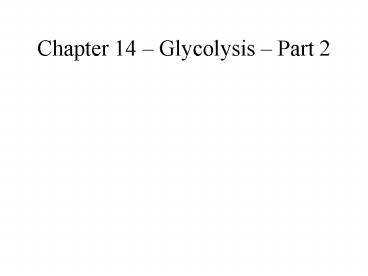Chapter 14 Glycolysis Part 2 - PowerPoint PPT Presentation
1 / 21
Title:
Chapter 14 Glycolysis Part 2
Description:
b. Anaerobic glycolysis (or lactate. fermentation with the production ... Lactic Acid Fermentation- Anaerobic Glycolysis Lactate dehydrogenase. Energy Balance ... – PowerPoint PPT presentation
Number of Views:64
Avg rating:3.0/5.0
Title: Chapter 14 Glycolysis Part 2
1
Chapter 14 Glycolysis Part 2
2
- Important points
- Glycolysis is a very important
- pathway in the metabolism of glucose.
- In glycolysis, 1 molecule of glucose is
- converted into 2 molecules of pyruvate
- with the net formation of 2 molecules
- of NADH and 2 molecules of ATP
3
- Pyruvate can participate in several
- different pathways
- a. Aerobic respiration which produced
- many molecules of ATP
- b. Anaerobic alcohol fermentation
- with the production of 2 ethanol,
- 3 carbon dioxide and 2 ATP
- b. Anaerobic glycolysis (or lactate
- fermentation with the production
- of 2 molecules of lactate and 2
- ATP.
4
- Glycolysis can be divided into
- two phases (1) energy-requiring and
- (2) energy-releasing.
- The energy-requiring steps require
- 2 ATP and result in the production of
- 1 fructose-1,6-bisphosphate.
5
6
Glyceraldehyde 3-phosphate dehydrogenase
H
High energy bond
Glyceradehyde 3-P
Aldehyde
Reduction
1,3-bisphosphoglycerate
Oxidation
Acid
6
Phosphoglycerate kinase
7
ATP is formed by substrate phosphorylation
Directly by an enzymatic reaction
7
What is the DGo ?
1,3-bisphosphoglycerate?3-phosphoglycerate Pi
DGo -11.8 kcal/mol
ADP Pi ? ATP
DGo 7.3 kcal/mole
1,3-bisphosphoglycerate ADP ?
3-phosphoglycerate ATP
DGo -4.5 kcal/mol
8
Phosphoglyceromutase
8
9
Types of reactions
- Mutase moves a group from one C to
- another.
10
Enolase
9
11
Pyruvate kinase
10
pyruvate
Substrate level phosphorylation
12
Energetics
Phosphoenolpyruvate ? Pyruvate Pi
DGo -14.8 kcal/mole
ADP Pi ? ATP
DGo 7.3 kcal/mole
Phosphoenolpyruvate ADP ? Pyruvate ATP
DGo - 7.5 kcal/mole
13
ATP Summary
-1 ATP
2 ATP net
- 1 ATP
2 NADH
2 ATP
Fig. 14.10
2 ATP
14
- Regulation
- Why?
- Where?
- At a point where the substrate is
committed - to a pathway
- At an irreversible step
15
Hexokinase Glucose-6-P
PhosphofructokinaseATP
Pyruvate kinase ATP
16
- Regulation
- Why?
2. Where? At a point where a substrate is
committed to a pathway At an
irreversible step
- What inhibits?
- Products
- ATP, glucose 6-P
17
Glucose Metabolism
Glucose (6C) 2 Pyruvate (3C)
2ATP
2NADH
Glycolysis
4ATP
2ATP
2 ATP
6CO2
8NADH 2FADH2
Ethanol CO2
Lactate (3C)
Anaerobic glycolysis
2ATP
Anaerobic alcohol Fermentation
Aerobic Respiration
18
Lactic Acid Fermentation- Anaerobic Glycolysis
Lactate dehydrogenase
19
Energy Balance
Conversion of glucose to pyruvate produces
2ATP
2 NADH
Conversion of pyruvate to lactate requires 2
NADH
Net in lactate production 2ATP only
20
Alcohol fermentation
Pyruvate ? acetaldehyde CO2
Pyruvate decarboxylase
Acetaldehyde NADH H? ethanol NAD
Alcohol dehydrogenase
Net (glucose?ethanol) 2 ATP
21
Energetics
Glucose? Lactate 2ATP -14.6 kcal/mol
Glucose? Pyruvate 2ATP 2NADH -29.5
Glucose? Oxygen 38 ATP -277 kcal

